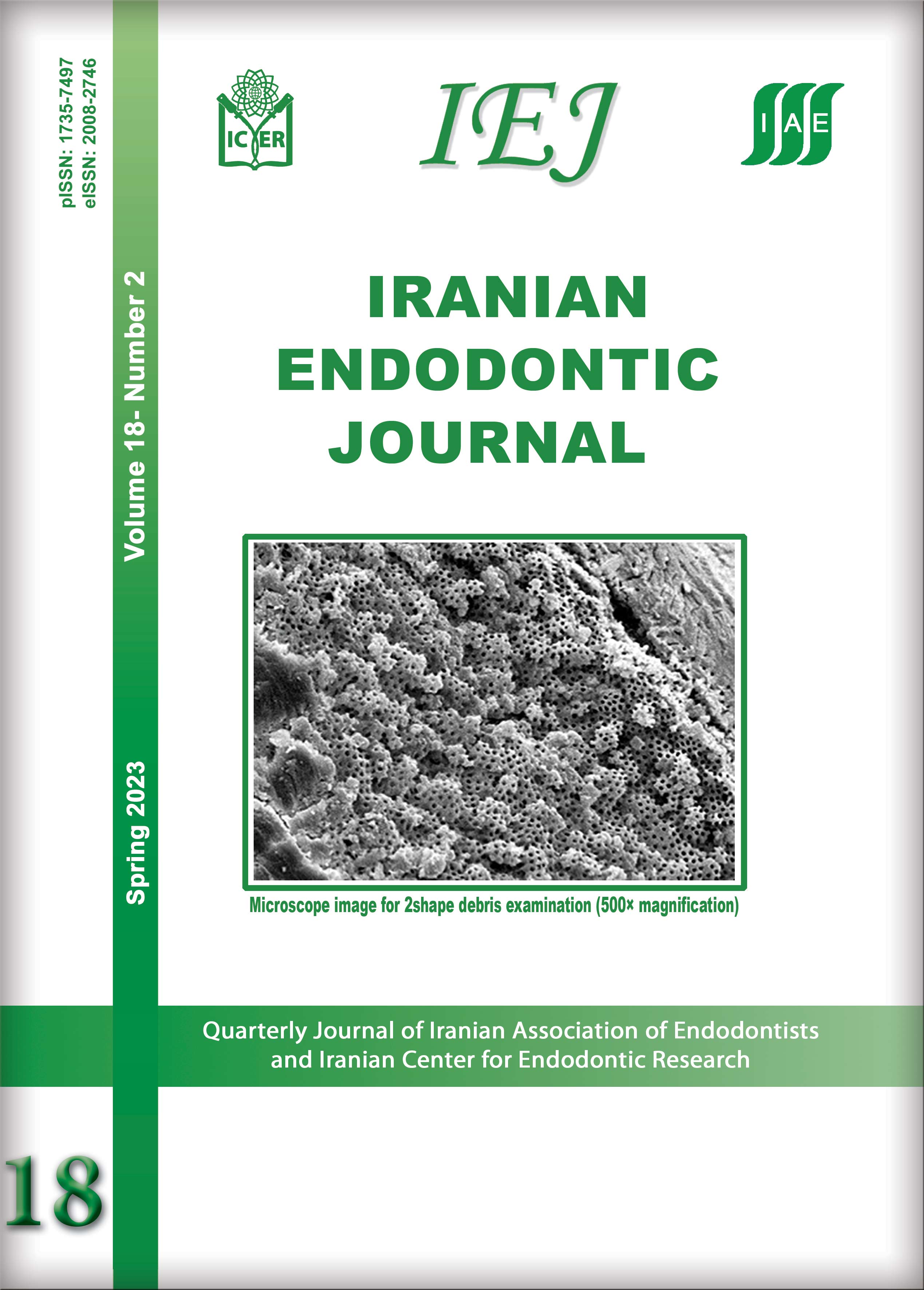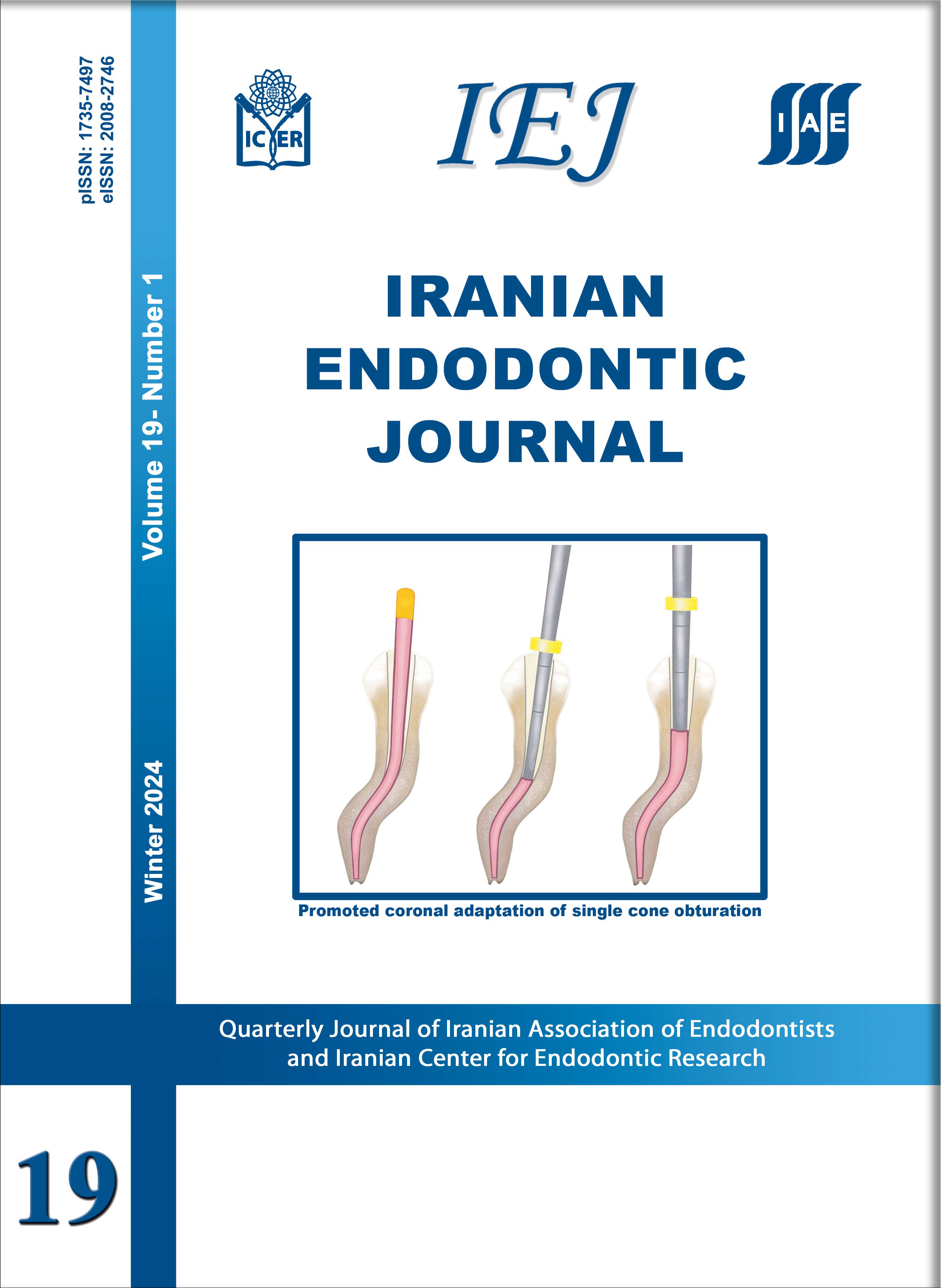Antibacterial Efficacy of Polymer Coated Ceramic Microparticles loaded with a novel combination of antibiotics on the Enterococcus Faecalis Biofilm
Iranian Endodontic Journal,
Vol. 18 No. 2 (2023),
16 April 2023
,
Page 85-90
https://doi.org/10.22037/iej.v18i2.33041
Abstract
Introduction: Nano-technology applied for the local delivery of different agents and/or drugs has made its path to endodontics. In the current study, the antibacterial efficacy of biopolymer-coated ceramic microparticles loaded with a modified combination of triple antibiotics, i.e. Penicillin G, Metronidazole and Ciprofloxacin (PMC), was evaluated against two strains of Enterococcus faecalis (E.faecalis); a standard clinical strain obtained from previously root-filled teeth with persistent periapical lesions, and compared to the most common antimicrobials used in endodontics. Methods and Materials: After synthesis of the polymer-coated microparticles loaded with antibiotics, the 21-day release of antibiotics were evaluated and a stock solution was produced using the maximum released amount of drugs and distilled water. The antibacterial activity of PMC, triple antibiotic paste (TAP), calcium hydroxide (CH), chlorhexidine (CHX) and sodium hypochlorite (NaOCl) against two bacterial strains was determined using “Minimum Inhibitory Concentration” and “Agar Diffusion Test”. Additionally, “Microtiter Plate Assay” was performed to assess anti-biofilm properties. Results: Minimum inhibitory concentration values reported for TAP and PMC were 1/256. PMC showed the maximum diameter of growth inhibition in both strains (33 mm and 35 mm), while CH had the minimum diameters (13 mm and13 mm). Based on microtiter plate assay, TAP showed higher biofilm formation than PMC. Biofilm formation was higher in the standard strain for PMC; however, NaOCl, CHX and CH completely inhibited biofilm formation. Conclusions: Based on the findings of the present study, it could be concluded that PMC and TAP were the most effective medicaments against E.faecalis in its planktonic form; however, none could inhibit its biofilm formation. Further studies using larger sample size and “Confocal Scanning Laser Microscopy” are recommended.
- Antibiotics; Biofilm; Enterococcus Faecalis; Microparticle; Microtiter Plate Assay
How to Cite
References
2. Siqueira JF, Jr., Rocas IN. Clinical implications and microbiology of bacterial persistence after treatment procedures. J Endod. 2008;34(11):1291-301.e3.
3. Orstavik D. Root canal disinfection: a review of concepts and recent developments. Aust Endod J. 2003;29(2):70-4.
4. Samiei M, Farjami A, Dizaj SM, Lotfipour F. Nanoparticles for antimicrobial purposes in Endodontics: A systematic review of in vitro studies. Mater Sci Eng C Mater Biol Appl. 2016;58:1269-78.
5. Puri K, Puri N. Local drug delivery agents as adjuncts to endodontic and periodontal therapy. J Med Life. 2013;6(4):414-9.
6. Parhizkar A, Nojehdehian H, Tabatabaei F, Asgary S. An Innovative Drug Delivery System Loaded with a Modified Combination of Triple Antibiotics for Use in Endodontic Applications. Int J Dent. 2020;2020:8859566.
7. Stuart CH, Schwartz SA, Beeson TJ, Owatz CB. Enterococcus faecalis: its role in root canal treatment failure and current concepts in retreatment. J Endod. 2006;32(2):93-8.
8. Love RM. Enterococcus faecalis--a mechanism for its role in endodontic failure. Int Endod J. 2001;34(5):399-405.
9. Du T, Wang Z, Shen Y, Ma J, Cao Y, Haapasalo M. Effect of long-term exposure to endodontic disinfecting solutions on young and old Enterococcus faecalis biofilms in dentin canals. J Endod. 2014;40(4):509-14.
10. Adl A, Shojaee NS, Motamedifar M. A Comparison between the Antimicrobial Effects of Triple Antibiotic Paste and Calcium Hydroxide Against Entrococcus Faecalis. Iran Endod J. 2012;7(3):149-55.
11. Haynes WM. CRC handbook of chemistry and physics: CRC press; 2014.
12. Etminaniesfahani S. Genotyping and drug susceptibility testing of Enterococcus strains isolated from root canal of tooth associated with pre-apical lesion. Tehran: Shahid Beheshti University of Medical Scienses; 2020.
13. Pumarola J, Berastegui E, Brau E, Canalda C, de Anta Jimenez M. Antimicrobial activity of seven root canal sealers. Results of agar diffusion and agar dilution tests. Oral surgery, oral medicine, and oral pathology. 1992;74(2):216-20.
14. Sabrah AH, Yassen GH, Gregory RL. Effectiveness of antibiotic medicaments against biofilm formation of Enterococcus faecalis and Porphyromonas gingivalis. J Endod. 2013;39(11):1385-9.
15. O'Toole GA. Microtiter dish biofilm formation assay. J Vis Exp. 2011(47).
16. Bahramian A, Shariati A, Azimi T, Sharahi JY, Bostanghadiri N, Gachkar L, et al. First report of New Delhi metallo-β-lactamase-6 (NDM-6) among Klebsiella pneumoniae ST147 strains isolated from dialysis patients in Iran. Infect Genet Evol. 2019;69:142-5.
17. Pinheiro ET, Gomes BP, Drucker DB, Zaia AA, Ferraz CC, Souza-Filho FJ. Antimicrobial susceptibility of Enterococcus faecalis isolated from canals of root filled teeth with periapical lesions. Int Endod J. 2004;37(11):756-63.
18. Neelakantan P, Romero M, Vera J, Daood U, Khan AU, Yan A, et al. Biofilms in Endodontics-Current Status and Future Directions. Int J Mol Sci. 2017;18(8).
19. Wilson C, Lukowicz R, Merchant S, Valquier-Flynn H, Caballero J, Sandoval J, et al. Quantitative and Qualitative Assessment Methods for Biofilm Growth: A Mini-review. Res Rev J Eng Technol. 2017;6(4).
20. Chávez de Paz LE, Bergenholtz G, Svensäter G. The effects of antimicrobials on endodontic biofilm bacteria. J Endod. 2010;36(1):70-7.
21. Zancan RF, Calefi PHS, Borges MMB, Lopes MRM, de Andrade FB, Vivan RR, et al. Antimicrobial activity of intracanal medications against both Enterococcus faecalis and Candida albicans biofilm. Microsc Res Tech. 2019;82(5):494-500.
22. Yang Y, Shen Y, Wang Z, Huang X, Maezono H, Ma J, et al. Evaluation of the Susceptibility of Multispecies Biofilms in Dentinal Tubules to Disinfecting Solutions. J Endod. 2016;42(8):1246-50.
- Abstract Viewed: 173 times
- PDF Downloaded: 178 times




